Washing Machine Repair
NOTE: Chapter 2 covers problems common to almost all washer designs.
THIS chapter covers only diagnosis and repairs peculiar to WCI / Frigidaire-designed washing machines.
If you do not read Chapter 2 thoroughly before you read this chapter,
you probably will not be able to properly diagnose your machine!!!!
As you can guess by the subtitle of this chapter, Frigidaire seems to have undergone more than its share of mergers and acquisitions. (see section1-1(a).)
For awhile there were two different designs, although they operated very similarly. These are referred to as the Westinghouse design and the Franklin design. Then they sort of "morphed" the two together, retaining the best design functions of each (in my never-to-be-humble opinion.) The design of their washer has undergone some dramatic evolution over the last few years, but the fundamental operation has remained basically the same.
These machines have a direct reversing motor which drives the transmission through a belt. A spring-loaded belt tensioner/idler assembly keeps proper tension on the belt and provides for pre-pump action. (see Figure F-1)
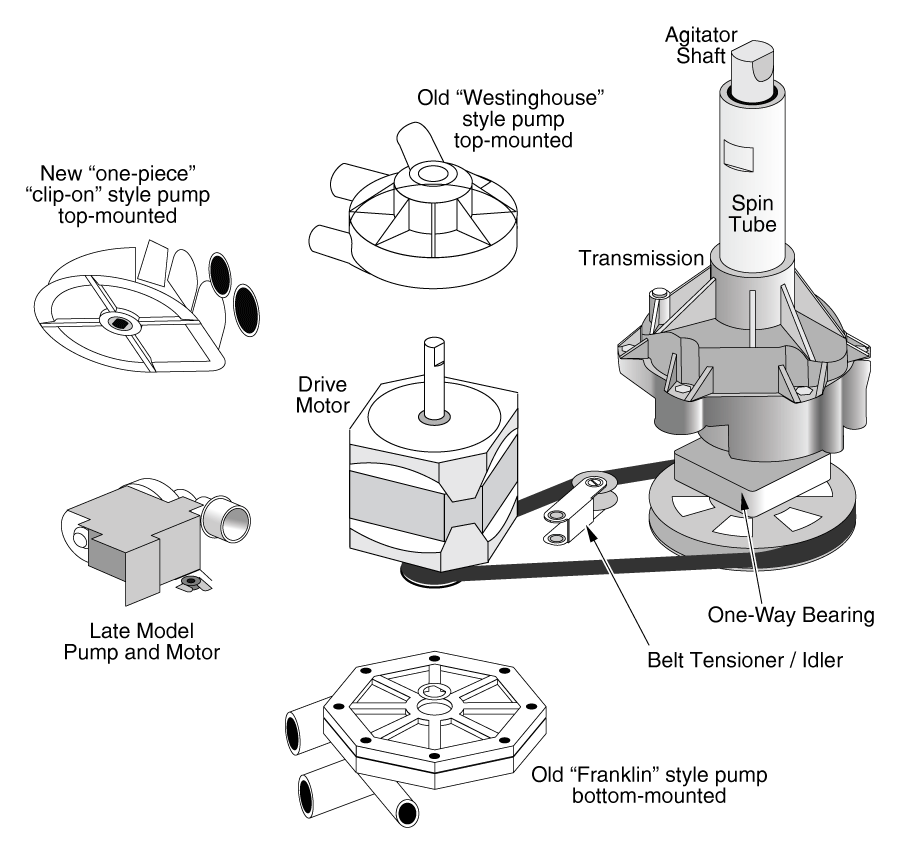
During the spin cycle, the whole transmission spins around. The spin basket is attached to the top of the transmission.
A clutch mechanism is integral inside of the transmission, which allows slippage until the basket and transmission come up to speed.
During the agitate cycle, the motor reverses and tries to turn the transmission backwards, but the transmission casing stays stationary and the internal gearing rotates. In late models, the bottom transmission bearing is a special one-way bearing; it will only allow the transmission to turn in one direction. In earlier models, this was done with an LGS spring setup. This is a spring with very tight coils that loosen when turning in one direction, but tighten around a shaft when rotation reverses.
In older machines, the pump is mounted directly to the top of the motor (Westinghouse design), or to the bottom of the motor (Franklin design). There was a "middle" version with a one-piece, non-rebuildable, top-mounted pump. 1995 and later models have a separate drain pump with its own drive motor, separate from the main drive motor.
The cabinet and console areas may be accessed as shown in figure F-2. Note that the Franklin design is slightly different from the Westinghouse design; it has a lower front panel that can be removed to access the transmission and other components.
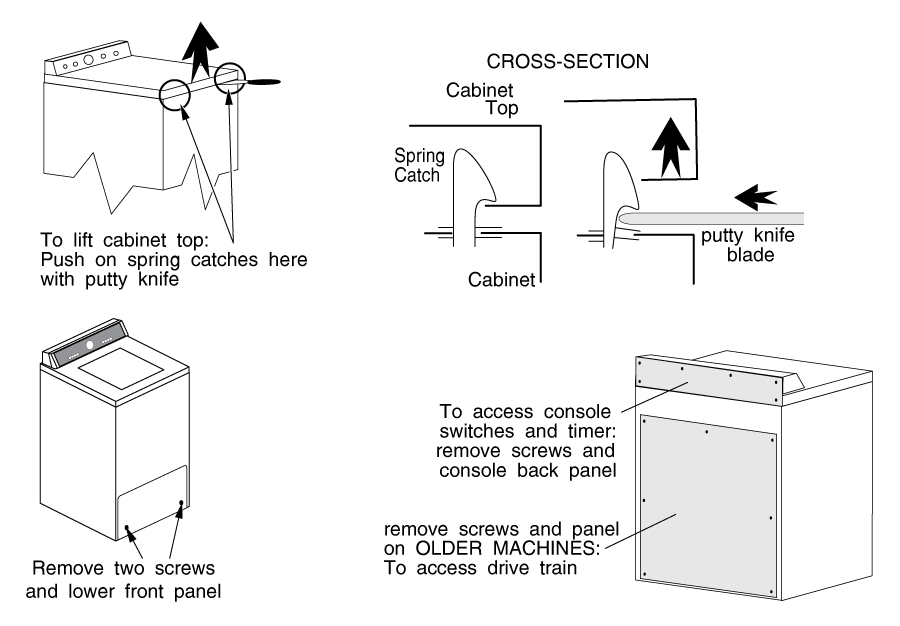
The most common problems with these machines are:
BELTS
The drive belts in these machines are subject to wear as described in section 2-5(a).
A worn belt can cause a variety of complaints; no spin, no drain, noise, burning smell, etc.
LID SWITCH
A broken lid switch will cause the machine not to spin, and leave the tub full of water.
WATER LEAKS
Water leaks may be coming from the usual places; pumps, hoses etc.
If the machine is leaking water and you cannot turn the basket easily by hand, you may have a major problem.
What happens is that the chrome surface of the spin tube wears out or gets rusted, and wears out both the water seal and the upper spin bearing.
You can replace the water seal and it will probably be good for maybe another six months. The solution, of course, is to replace the transmission, but it's not cheap. See section 9-7.
PUMPS
These machines experience the usual pump problems and leaks as described in section 2-3. These machines seem to be particularly susceptible to overloading; if you overload the machine, small items such as baby socks spill over the top of the basket, and get sucked into the pump.
The old-style Westinghouse and Franklin pumps can be rebuilt. The new clip-on pumps and pump/motor units cannot. See section 9-6.
The motor-driven pump in late-model machines is of a little lower capacity than the old pumps driven by the main drive motor. If the end of the drain hose is too high, the pump may not completely drain the tub before the drain cycle ends. If you have water left in the tub at the end of the cycle, investigate this possibility.
TRANSMISSION PULLEY
Some of these machines have a transmission pulley that is held on with a set screw, which has been known to back out. This can cause a number of different symptoms, such as noisy operation, burning belts, or if the pulley falls off, no agitate or spin. See section 9-5.
LGS SPRING / ONE-WAY BEARING
Older machines had an LGS spring in place of the one-way bearings used in the newer machines. (Figure F-3) The LGS spring can get rusty, or things can get stuck between the tub and the basket, and cause the machine to "labor" during the spin cycle, and possibly even trip out on the motor overload switch.
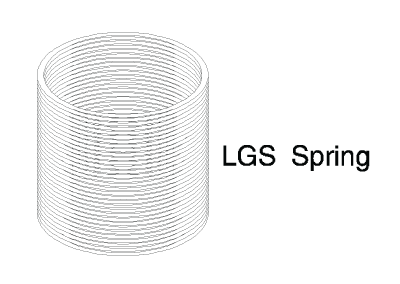
Through '93 there was a black plastic cover over the LGS spring. from '94 to '96 they used an LGS spring without a plastic cover, and in '97 they went to the one-way bearing they use now.
If your LGS spring is rusty, you can try lubricating it with a very light oil such as turbine oil or 3-in-1.
You can also replace the LGS spring with the new one-way bearing , but it is not cheap. Ask you parts distributor for available kits and pricing.
DRIVE BLOCK
In older machines, a knocking sound during the agitation cycle usually indicates a worn drive block. It can be replaced, but you need a wheel puller to get the old one off. (Figure F-4)
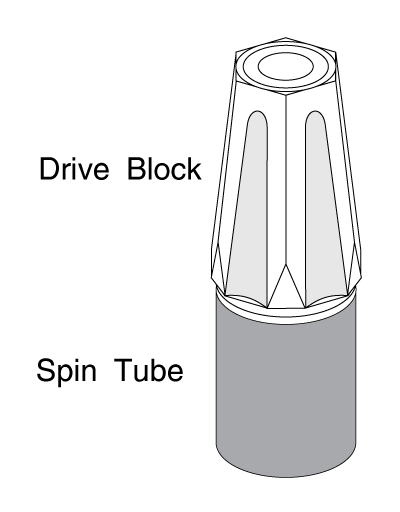
Since drive belt tension is kept by a spring-loaded idler, replacement is easy. When replacing the belt, ALWAYS check that the idler arm pivots freely and that the idler pulley turns freely. It's a good policy to just replace the idler whenever you replace the belt.
Older machines had an idler pulley with several spring adjustment notches in the idler arm. (FIGURE F-5) If you have one of these, note the notch that the tension spring is in BEFORE you remove the belt.
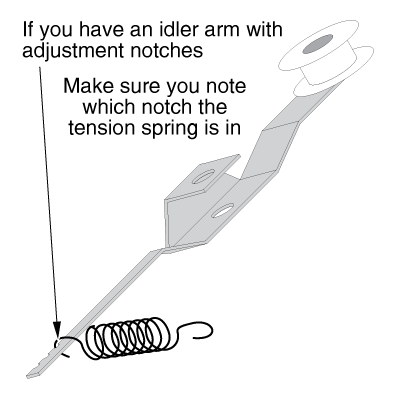
Proper belt adjustment is important in these machines, so make sure you get everything back in the same place. If the belt is not adjusted properly, you may hear a clattering noise during spin (this is the idler touching the motor mounting plate; too loose) or you will notice excessive belt wear (too tight.)
Newer models do not have this adjustment.
If you have a bottom-mount Franklin style pump, you will also need to remove the pump to remove the belt.
There is a set screw that holds the transmission pulley to the transmission shaft. If this pulley loosens, it can score the transmission input shaft. Sorry to be the bearer of bad tidings, but there is no way to repair this shaft. If this happens to your washing machine, you will probably end up buying a new transmission, or a new machine.
Old-style Westinghouse and Franklin pumps can be rebuilt. Clip-on pumps cannot.
The old-style Westinghouse-designed pumps are assembled onto the motor shaft. In order to service them, the whole pump and motor assembly must be removed.
The top-mounted clip-on pumps and Franklin pumps can be removed from the motor in one piece.
Both the Westinghouse and Franklin washing machine pumps have carbon seals. These are sensitive to the distance of the pump body from the motor for proper sealing. The Westinghouse pump is particularly sensitive to this. When disassembling these pumps, note the exact position of every shim, grommet and washer. And be absolutely certain that every single one goes back in the same place, or your pump will leak. Also, make sure the carbon sealing rings stay absolutely clean; in fact, try not to even touch the sealing surfaces with clean fingers if you can avoid it. The body oils and acids on your fingertips may etch the seal and shorten its life.
In disassembling these pumps, also note that some of the screws hold the pump body together, and some hold the pump body to the motor. Be careful when tightening the screws that hold the plastic pieces together; it's easy to strip plastic threads by overtightening. Snug is all you need. Let the gasket do its job.
After you re-assemble either pump, turn the motor over by hand and feel for any rubbing. If the impeller is rubbing the pump housing, the distance between the pump body and the motor must be shimmed according to the instructions that come with the pump rebuilding kit.
FRANKLIN PUMP (Figure F-6)
These pumps can be removed from the motor by taking out the allen-head setscrew that holds the impeller to the motor shaft (Figure F-6.) Then remove the hoses and drop the pump off the motor shaft.
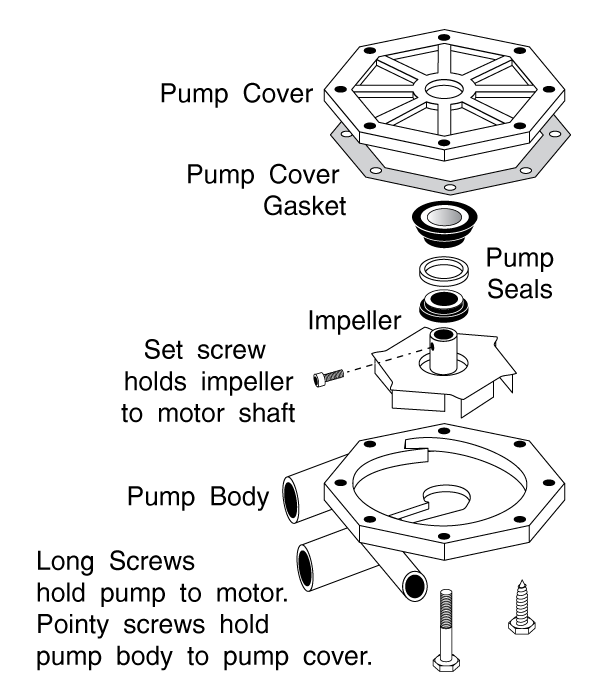
WESTINGHOUSE WASHING MACHINE PUMP (Figure F-7)
When removing the motor and pump assembly, be extra careful not to get any water in the motor.
When re-assembling the pump, keep in mind that there are two sets of holes for mounting the pump body to the motor. These holes are marked "G" and "W." The motors used in these machines came from two different suppliers, GE and Westinghouse, each of which had different pump body mounting holes. Either motor will replace the other, but to get the proper pump hose alignment, use the right set of holes.
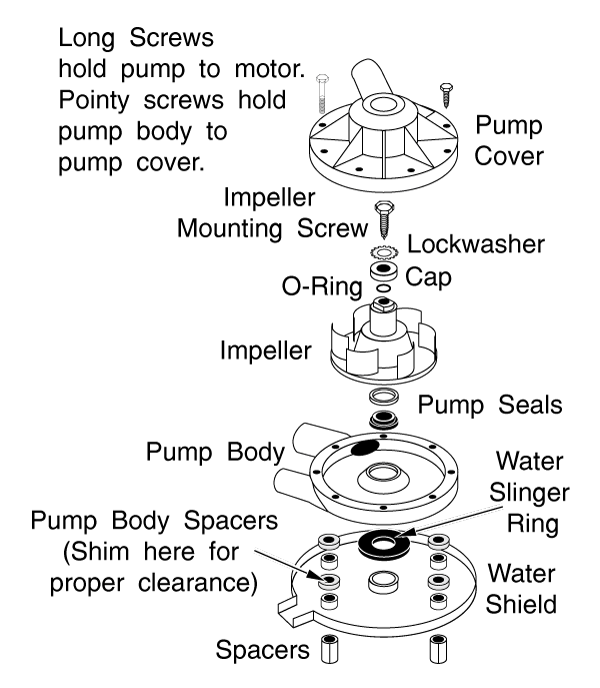
Transmission removal and replacement is pretty straightforward in these washing machines; there are no special peculiarities or tricks to it. I would caution you, however, to price out the project first, and assume that you will have to replace both the bearings, all seals, the trunnion, and the belt and idler pulley. After comparing this to the cost of a new machine, most people tend to favor buying a new machine.
Please share our .